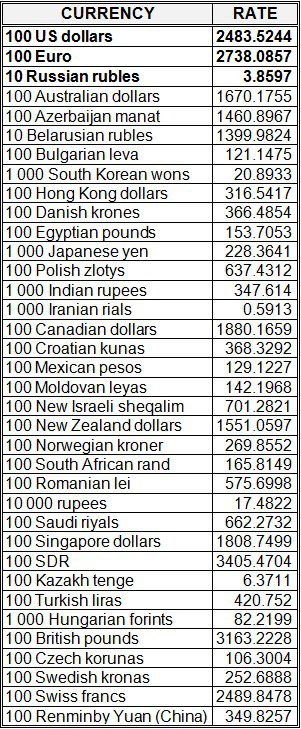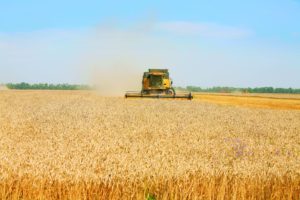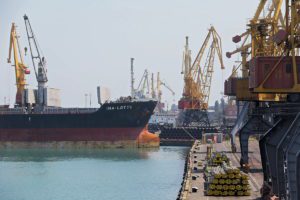National bank of Ukraine’s official rates as of 17/10/19

Source: National Bank of Ukraine

KSG Agro next year plans to boost grain and wheat flour export to Oman, Qatar, Libya and Angola 2.8 times compared with 2019, to 50,000 tonnes.
The holding said in a press release that in 2019 KSG Agro plans to export up to 18,000 tonnes of grain and flour to these countries, and at present, 11,800 tonnes of goods have been delivered.
The company said that in 2019, the agricultural holding exported cereals and flour exclusively to Oman, Qatar, Libya and Angola.
“We are very interested in exporting to the markets of the Middle East and Africa, where there is a demand for our products. Expanding agricultural exports allows us to diversify sales channels and receive foreign exchange earnings, as well as increase margins,” KSG Agro Board Chairman Serhiy Kasianov said.
In 2018, KSG Agro delivered 5,000 tonnes of corn to Oman and Qatar, in 2019 the export of this crop to two countries amounted to 5,300 tonnes. In addition, this year, the agricultural holding exported feed barley to these two countries in the amount of 4,000 tonnes. Also in 2019, KSG Agro delivered 2,500 tonnes of wheat flour to Libya and Angola.
“Thus, the total export volume of agricultural products of the agricultural holding in 2019 increased 2.4 times compared to 2018,” KSG Agro said.
KSG Аgro is a vertically integrated agricultural group, working in almost all the segments of the agricultural market, including the production, storage, processing, and sale of agricultural products.

The Odesa seaport in January-September 2019 handled 18.152 million tonnes of cargo, which is 17.5% more than a year ago.
According to the Ukrainian Sea Ports Authority, over the period the port increased handling of exported cargo by 20%, to 13.375 million tonnes and imported cargo – by 12.7%, to 3.669 million tonnes, and coastal cargo 3.3 times, to 172,300 tonnes. Transit cargo transshipment fell by 6.2%, to 934,100 tonnes.
According to the types of cargo, the port in January-September 2019 increased the transshipment of liquid cargo by 16.7%, to 1.262 million tonnes, increased the transshipment of dry bulk cargo by 27.6%, to 7.51 million tonnes, and increased the transshipment of packaged goods by 10.6%, to 9.379 million tonnes.
Container handling amounted to 470,857 TEU (a rise of 10.8% year-over-year).
Odesa port is located on an area of 109.5 hectares.
The port accepts vessels with lengths of up to 270 meters and maximum draughts of 13 meters. The total length of the port’s berths exceeds 8 kilometers.

Cattle livestock in Ukraine (excluding the temporarily occupied territory of Crimea, Sevastopol, parts of Donetsk and Luhansk regions) as of October 1, 2019 amounted to 3.597 million animals, which is 5.1% down on the same date in 2018, the State Statistics Service has reported.
The number of cows by this date also decreased 4.8%, to 1.89 million head.
According to the State Statistics Service, the number of pigs as of October 1, 2019, fell by 3.1%, to 6.25 million animals, the number of sheep and goats declined by 3.2%, to 1.47 million animals compared to the same period of 2018.
The number of poultry in the country compared with October 1, 2018, increased 4.6%, to 249.797 million birds.

The Blockchain Association of Ukraine (BAU) has proposed to make Ukraine competitive jurisdiction for companies dealing with cryptocurrencies and blockchain technology and proposed some principles for being implemented into the law, including the introduction of 5% tax on deals with cryptocurrency.
The respective document was posted on the association’s website last week.
According to the text of the document, proposals for implementation in the legislation in the field of regulation of cryptocurrencies were developed with the aim of accelerating the pace of development of this market.
In particular, according to the association, cryptocurrency exchange and sale transactions should not be subject to VAT and cryptocurrency suppliers should not be tax agents of individuals. For transactions with cryptocurrency, personal income tax should be levied at a rate of 5%, and the tax base should be net profit for the reporting year.
Blockchain Ukraine also proposes to introduce licensing of the exchange of cryptocurrency for fiat currencies.
The BAU said that the proposals of the association were accepted for consideration by the Ministry of Digital Transformation of Ukraine and the interfactional parliamentary association of the Verkhovna Rada Blockchain4Ukraine.
In the near future, it is planned to sign a memorandum of understanding and cooperation between the Ministry of Digital Transformation and the community of blockchain and crypto companies.
The Blockchain Association of Ukraine brings together experts in the blockchain industry and is a non-profit organization that actively promotes the integration of blockchain technology into the Ukrainian economy. The main mission of the association is to develop multilateral dialogue, the result of which will be consensus in all areas of activity.

State-owned enterprise Artyomsol (Donetsk region) produced over 1.48 million tonnes of salt in January-September, which is 2.6% more than a year ago.
According to the report on the website of the state-owned enterprise, from the beginning of the year, Artyomsol produced 338,500 tonnes of bulk milled salt, which is 20.7% higher than in January-September 2018.
The output of salt packaged in flexible containers increased 13%, to 49,300 tonnes, salt blocks – by 15%, to 2,300 tonnes.
At the same time, according to the information of the SOE for the first nine months of this year, the production of packaged salt decreased by 8.9%, to 134,700 tonnes. Production of salt packed in bags was less than 4.9%, salt briquettes – 18.7% compared with the same period a year earlier. In addition, iodized salt production was 13.1% less (only 41,700 tonnes).
The state-owned enterprise said that 763,100 tonnes of salt were shipped to foreign consumers in January-September 2019, which is 8% more compared to the same period in 2018.
Hungary, Poland, Slovakia, and Romania remain the main importers of Artyomsol products.
“The results of the enterprise’s work were significantly affected by the steadily increasing cost of transportation of goods by rail by Ukrzaliznytsia. This factor reduces the competitiveness of salt of the Ukrainian producer,” the company said.
Artyomsol is the largest enterprise for extraction and sale of sodium chloride (NaCl) in Central and Eastern Europe. Its production facilities are located in Soledar (Donetsk region). The company exports products to 15 countries.